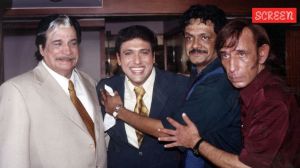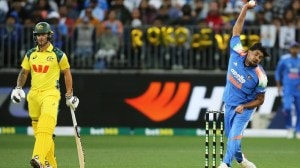The Swingers
UNDER Delhi’s wintery sun, shadows are already lengthening at 3 pm. At a tree-ringed ground on the city’s outskirts, Jhulan Goswam...

UNDER Delhi’s wintery sun, shadows are already lengthening at 3 pm. At a tree-ringed ground on the city’s outskirts, Jhulan Goswami, 22, is working up reasonable pace at the nets. With a fluid action and an ability to generate movement off the pitch, every so often she catches a crack in the track and forces the batter to take evasive action. A few feet away, protected from the sudden fury of cracking shots by a neat formation of kitbags, Mithali Raj contemplates the month ahead.
Already Captain of the Indian women’s cricket team at 22, Raj has the composed air of a veteran. When her squad takes on England in the one-off Test in New Delhi on November 21, she says, they will have more than just home advantage.
Raj believes that Indian women, in particular, are adept at swinging the ball. They are, she reminds you, coming off a dream run at the World Cup, where they reached the finals, losing to Australia more due to big match nerves (causing four of the main batswomen to be run out) than any lapse in technique. ‘‘We have young blood and experience,’’ she beams. The average age in this team is 24.
The England team comes off an Ashes victory and the current series will set up another encounter in the summer, when India will play at Lord’s for the first time and the English girls will play there after five years.
Coach Sudha Shah has a word with all-rounder Rumeli Dhar, 21, and debutante Asha Rawat, 23. You appeared anxious to convert every delivery, she tells them, you don’t have to do that in a Test—if there’s a short ball, sure, hit it, and do what you want after you get 50. ‘‘They are such a happy bunch. It makes my job so easy and enjoyable,’’ says Shah.
Shah has been intimately involved with the game almost since the time women’s cricket was formally organised in India in 1973, with the registration of the Women’s Cricket Association of India (WCAI). As a teenager, she played in India’s first women’s Test in 1976, and can now readily spot the changes driving the team to what could be a tipping point—toward greater visibility and recognition. ‘‘Then,’’ she says, ‘‘we didn’t place that much stress on fitness. Now the facilities are better. The girls are exposed to many more matches on television.’’
So here at the 10-day training camp in Gurgaon, there is a sense of hope of catching women’s cricket at a cusp. On view are exceptional talent, extraordinary records and a motivation born of professional training. But palpable amidst the good cheer is the yawning gap in the support structure that Shah and officials of the WCAI must struggle to provide.
IN accordance with International Cricket Council (ICC) guidelines, in most cricket centres the women’s and men’s organisations have been merged—in Australia, England and New Zealand, for instance. But not in India. This means Indian women do not get access to funding and facilities from the Board of Control for Cricket in India (BCCI). There is an ICC deadline, but till the BCCI and WCAI work out the modalities—no prizes for guessing which is the dithering party—women cricketers must rely on outside help.
Like the Tata Energy Research Institute which provides this Gurgaon ground. Or Infosys, which gives the team use of the quality field, gym and residential facilities at its Mysore campus—as well as motivational talks by founder NR Narayana Murthy and chief financial officer Mohandas Pai. There is a team sponsor, Sahara, but not much else by way of endorsement.
‘‘This means domestic competition suffers and there are hardly any funds for development of the game,’’ says Shubhangi Kulkarni, honorary secretary of the WCAI. “Corporate India has to start looking at different games.” At present, only two organisations employ female cricketers, the Indian Railways and Air India. And since each Test match fetches a player Rs 3,000, and each one-day international Rs 1,000, the women cannot count on the game itself to support them financially.
MANDIRA Bedi’s post-noodle straps association with the women’s game has brought greater visibility to it. She offered herself as mascot and made it a point to be at key international fixtures. Says Kulkarni: “Mandira has brought a lot of glamour to women’s cricket.” The recent appearance of Anjum Chopra, stylish left-hand bat who elicits comparisons with David Gower, on Doordarshan’s wrap-ups of the men’s ODI matches against Sri Lanka, also helped. She has, to put it politely, alerted viewers and garrulous commentators to the possibility that women may know a thing or two about cricket after all.
Their performance certainly shows that. For a couple of years, Mithali Raj held the highest Test score (214 against England at Taunton, 2002). Neetu David, who along with Amita Sharma, 21, is always ready with a joke and a giggle, is the only woman to have scalped eight wickets in a Test innings. And this year, of course, they reached the final of the World Cup in South Africa.
Kulkarni says she was disappointed with the response to that achievement. Agrees Shah: ‘‘I expected a little more recognition. It is sad that we are still struggling with sponsors.’’
“Itna pharak kyun?” demands Rawat. But the Delhi girl is far too excited about the possibility of a middle-order debut to be contained by resentment about cricket’s great gender divide. The prospect of playing for India is too energising. And so far it’s been a dream run. She had been concentrating on athletics till 2001, when she batted for Kamla Nehru College in a university tournament. The past three years have seen her chisel that raw talent, connecting her cut shots more effectively and learning to play in the V. And unlike most of her teammates, in the men’s comeback season, she doesn’t make detours to the radio for the latest score. “I’m not interested in watching cricket the way I’m interested in playing.”
FOR Mithali Raj, engagement with the game goes back longer. At the age of 10, she followed her brother into a cricket camp. “The camp was exclusively for boys,” she recalls. “So I was given a lot of importance, I got to bat first.” For a long while, after her brother gave up the game to concentrate on studies, she divided her passion between cricket and Bharatanatyam. But in 1997 she was selected for the World Cup preparatory camp, and she had to make a choice. After eight years of training she gave up dance. “Studies too took a back seat,” she confesses, but says she is determined to clear the final year examinations for her bachelor’s degree.
“I used to open batting and bowl,” she says, “but with higher scores, bowling faded away. Now I’m a pretty good bat.” To put it mildly! In four Tests she averages 78.25 and over 56 ODIs she averages 48.40.
Like Shah and Kulkarni, Raj knows of many talented cricketers who gave up the game because of anxiety about their job prospects. And it does trouble her that their away matches are not telecast live, but the response in smaller domestic centres is overwhelming. “In Dhanbad recently, tickets were sold in black. In Aurangabad some viewers were perched on trees.” So while she considers Tests the real cricketing experience, she says it may be just as well that they play many more ODIs: “They attract the crowds. If we popularise one-dayers, then interest in Tests will follow.”
David is looking forward to the November 21 to 24 Test. Often compared to Bishen Bedi for her looping action, she enjoys long “35-over” spells. Talk about the eight-wicket record, and she laughs: “That was in 1995! Only now are people beginning to talk about it.” Now 28, she made her debut in 1993, and in the past 12 years can discern many changes in the game. “There were very few international matches earlier. There were no sponsors. Now, especially after the World Cup, the media is taking note of us.”
Since 2003, there’s been a greater emphasis on fitness with gym work, aqua aerobics and yoga—a trainer, physio and sports psychologists are now part of the entourage. ‘‘Our batting and bowling have always been very strong. We would lose out in running between the wickets and fielding,’’ says Shah.
Off-season, each player is given a personal regimen. David points out that many of the girls are rather shy, so motivational talks help. Mentally rehearsing the possible drift of play too relaxes them.
But nothing, says Jhulan Goswami, who debuted in 2002, can compare with the thrill of representing India. “It is a great feeling. Like reaching heaven.”
trailed behind her brother into a cricket camp, she says there was nothing tomboyish about her. She was also devoted to her Bharatanatyam training, and her teacher would sometimes joke, ‘‘How will your make-up show if you get so tanned?’’ Summons to the national camp later demanded a choice, and she gave up classical dance after eight years of training. Now she is determined to get her bachelor’s degree.
NEETU David
says she loves being compared to Bishen Bedi, but wonders when her record eight-wicket haul and bowling action will fetch her her own identity. In 1992, David was in Class 10 when she took part in the budget trophy in her home town Kanpur. But it was a year later when she was called to the national team that she accepted cricket as a serious career option. The only sportsperson in her family, she says she got her parents’ full support and in the early years, her mother would chaperone her to various venues. Having scalped Mohammed Kaif once, she wonders when her teammates will create the kind of buzz that the men do.
JHULAN Goswami
was 15 and an enthusiastic participant in tennis ball cricket matches on the streets of Kolkata when the Women’s World Cup final came to Eden Gardens in 1997. Already inspired by Glenn McGrath and Javagal Srinath (who she is still to meet), the experience motivated her to sign up with a local coach. Now India’s medium-pace hope says her family is very supportive but would like her to take a break from the game to clear her Class 12 Board exams.





- 01
- 02
- 03
- 04
- 05


























